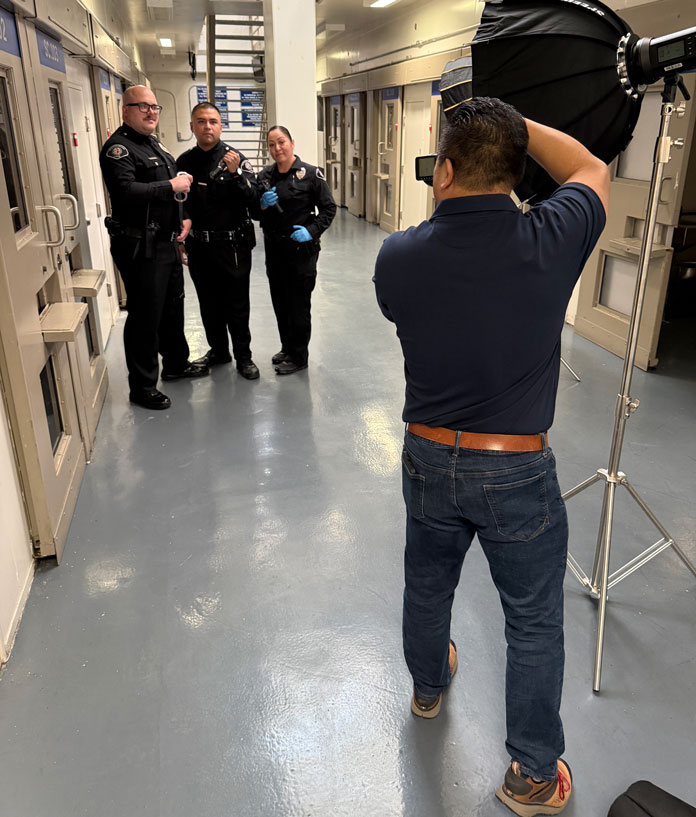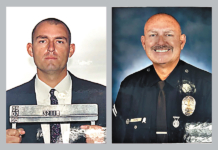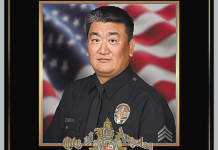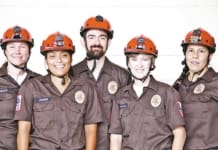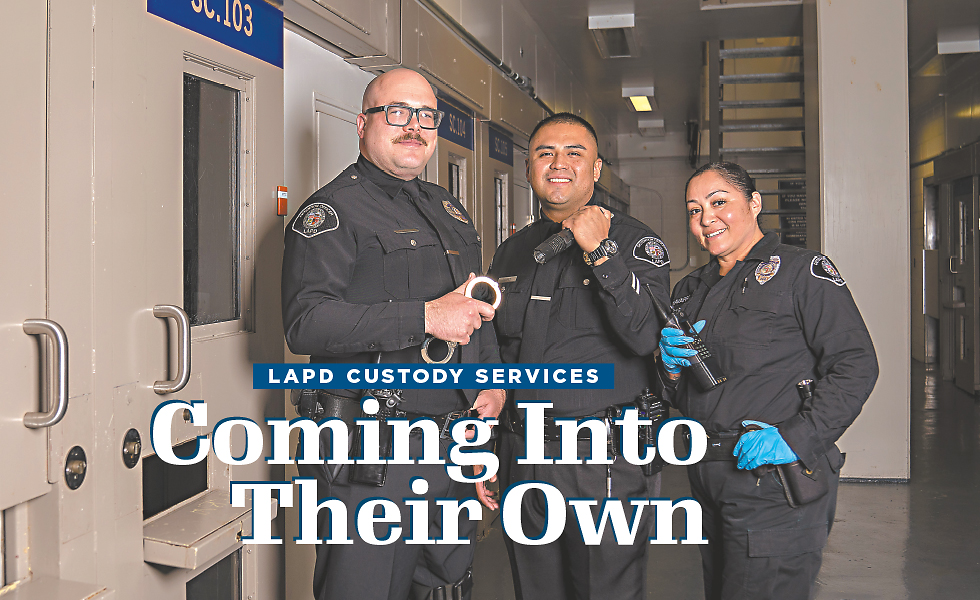
Alive! photos by Summy Lam
Between arrest and court appearance sits a critical function of policing.
The LAPD entrusts that function to its Custody Services Division. (From its beginning to 2016, it was known as Jail Division.) That mission: to provide professional and compassionate care and custody for those who are entrusted to its Detention Officers. The division ensured that the constitutional rights of these individuals, whom Officers take oaths to protect and serve, are adhered to as they move through the legal system.
The Division is responsible for the care and custody of all arrested persons within the LAPD. The Custody Services Division also physically maintains and supervises all of the jails used by the department.
Jails operated by the LAPD are:
• 77th Street Regional Jail
• Harbor Area Jail
• Hollywood Area Jail
• Metropolitan Detention Center
• Pacific Area Jail
• Valley Jail Section (Van Nuys Area)
Administrative Section
The Administrative Section is responsible for maintaining records and processing reports concerning all arrestees incarcerated; regulating arrestees’ visitations and correspondence; conducting research of jail rules, procedures and related legal opinions, and developing projects and methods for improving division efficiency; training new Division personnel, civilian and sworn, in jail techniques and procedures; and developing and presenting specialized training.
Size
Custody Services staffs approximately 375 Officers. That includes 270 Detention Officers and 75 civilian Supervisors and sworn Police Officers and command staff. The division also includes approximately 50 medical staff, which reports to the Medical Services Division of the City.

Duty and Compassion
On Feb. 19, Club CEO Robert Larios and Alive! editor John Burnes interviewed Sr. Detention Officer Corey Gravel, 6 years of City service; and Detention Officer Eric Ramirez, 12 years, Club Member. The interview was conducted via Zoom from the Metropolitan Detention Center downtown.
Alive!: Thanks for joining us today as we feature Custody Services.
Let’s talk first about your City careers.
Detention Officer Eric Ramirez: Of course. I started with the City in 2012, fresh out of high school. I was working as a Messenger Clerk with the Library and taking classes at East Los Angeles College. At East Los Angeles College I developed an interest in going into law enforcement – it has an administration of justice program. I just happened to take an elective. My instructor was a Retired LAPD Sergeant, and he pushed me to start a career in law enforcement. The class itself piqued my interest. Since I was already a City employee, I checked the Personnel website, and I saw this Detention Officer position. The unique thing about this position is that the LAPD would take you at 18 years of age, so you don’t have to wait for 21 years to become a sworn Officer. When I applied, I was 19. I got in at 20 years old, and I’ve been here ever since.
At three years on the job, I became a Jail Training Officer; I’ve been a Jail Training Officer for a little more than seven years now. As a Union Steward and Bargaining Chair for Detention Officers for the last 8 years, I’ve negotiated our contracts and have represented Detention Officers and other Public Safety Officers throughout the city. I’ve been nominated for the SEIU 721 Executive Board, our union, because of my work and am a current candidate for the SEIU 721 Executive Board of 2025. I also assist with our recruitment and attrition of Detention Officers. It’s been a very rewarding career for me.
What drew you to wanting to be a Detention Officer?
Officer Ramirez: To be perfectly honest with you, I was very interested in the jail setting. I wanted to be in law enforcement. I wasn’t sure about going to patrol. I felt that this was a good way to gauge my interest in that. I ended up enjoying the position and staying here for the last 10 years.
Sr. Detention Officer Corey Gravel:I graduated back in 2009 with a Bachelor’s degree in psychology. I started off as a behavioral therapist for special needs kids – I would teach them social skills and how to behave appropriately. And then I transitioned that into a school setting where I worked as a behavioral crisis response team for a junior high and high school district in my area. Basically I would instruct special education teachers and their staff on how to deal with problematic behaviors from their students. As things got more dangerous, they would call me and I would actually respond directly to it. I was always thrown in the mix of having to respond to dangerous or stressful situations that could be a liability. It wasn’t a far stretch to come into Custody Services as far as that’s concerned. I’m not going to say the clientele is the same. But I will say that being able to maintain your composure when the people you are working with are doing everything in their power to make you lose your composure made it a very easy transition to Custody.
As of yesterday, I’ve been promoted to Sr. Detention Officer. I’m now a Supervisor overseeing the wonderful Officers I get to work with.
Congratulations!
Officer Gravel: Thank you.
Absolutely. Talk about the parallels between what you did before and what you do now.
Officer Gravel: I have seen some of my old clients in the behavioral therapy setting come through our facilities here at Custody Services, and the easiest parallel to draw between them is that everyone deserves respect and fair treatment. That is something that the LAPD is looking for when they hire Officers on the sworn or civilian side. Can you be empathetic to people who are having a bad day or even having their worst day? That was the easiest sell for me – yes, I can maintain my composure when things are going wrong, but how empathetic am I to the situations that people wind up in, not necessarily to their own fault? That’s a key ingredient that we look for in the Detention Offices we hire now.
 The Division
The Division
In general terms, describe Custody Services – what it’s all about, and simply put, what do Detention Officers do?
Officer Ramirez: Custody Services is the bridge between the arrest and the custody setting. We provide the custody expertise to our department when it comes to the arrest. Detention Officers are tasked with caring for and maintaining the welfare of LAPD arrestees. We’re charged with screening them, processing them through the system to prepare them for arraignment, and to prepare them for the next facility that they may be going to or to release them from custody.
The job has changed a lot throughout the years with the duties that have been tasked to us from past years up until now. The division operates kind of in the shadows for the LAPD. When you think LAPD, you think patrol. A lot of people are unaware that there’s a custody aspect to the LAPD as well. That’s where we come in. It’s a strong supporting factor of the department.
Officer Gravel: What people mostly don’t know is that an arrest can be completed in a matter of an hour to hours, but a custody action holding that person in detention before they have their due day in court could be up to six days. The Custody Services Division is the care, safety and welfare of the individuals. Our facility is a pre-trial, type 1 facility. One of our crucial duties is to ensure that arrestees have their day in court and that they get there safely.
Officer Ramirez: We deal with everything. We have to. We have to care for arrestees as far as their medical services. Arrestees who have mental or medical issues. We provide to the best of our ability with medical care, if we cannot they will be transferred to a facility that can provide the medical attention. Any medical issues that are brought up to our attention will be provided with medical care. The wellness and safety of arrestees that come into our facility is a priority. But it could be challenging with the difficulties that we face with arrestees who come in with mental illnesses or with substance abuse who are going through withdrawal. The work experience and training we have, help us to identify factors to maintain an arrestee’s welfare and safety of personnel. Our Detention Officers do a lot. We’re the care professionals part of the LAPD. Our existence allows patrol to focus on patrol, and we focus on custody.
Providing healthcare to the arrestees must be a big part of the services that you provide.
Officer Gravel: Oh yes, I would say a majority of the clientele who come through our facilities have either mental illness, a drug addiction or a comorbidity combination of the two. Having to address those factors means that we have to have a lot of training and doctors on staff. We make assessments before they even come into our custody from the Officers in the field to ensure that we have everything necessary to ensure that these individuals will have their medications ready. Can we take care of them while in our custody? We have medical staff and Officers on duty 24/7. Seven days a week, 365 days a year, no days off.
Wow. And speaking about doctors and your medical staff, how many employees does the division have, including those in the medical area?
Officer Ramirez: Our division staffs around 375 Officers. That includes 270 Detention Officers, 75 civilian Supervisors and sworn Police Officers and Command staff. Our medical personnel correspond more with the Medical Services Division of the City, a different department. They’re not directly under the Custody Services Division.
Officer Gravel: Each regional jail has a medical facility and is staffed, to ensure all arrestees needing medical attention gets evaluated.
How many locations do you have?
Officer Ramirez: The LAPD has 10 jails throughout the City. Currently we have only six that are open. We have three regional facilities. The Metro Detention Center is the hub, the main, the center. We have Valley Jail that’s a regional facility in Van Nuys. We have 77th Regional Jail as a regional facility in South LA. Aside from those three regional jails, we have three outline jails – one in the Harbor, one in the Pacific area and one in Hollywood.
How many guests – inmates – do you have under supervision?
Officer Gravel: The number of arrestees in our custody is always changing, an arrestee can be held for court in our facility or cited out the same day.
Officer Ramirez: We have the capability to house around 300 to 400 arrestees here at Metro Jail. Because laws change and other factors, our population has decreased. But on a busy weekend we can book upwards of hundreds. Our facilities are considered level one facilities, which house the pre-arranged. Once they are ready for arraignment, we send our arrestees there. If it’s decided that they continue to be jailed, they are transferred to the County jail. We don’t get them back for that longer term of custody. Over the weekend is where we get a large population because we have nowhere to send them until the next arraignment date.
Is Metro the newest?
Officer Ramirez: MDC has been around for about 15 years. It is our newest facility. What I find really great about this facility is that it’s very modern. I won’t go into all the details for security reasons, but a lot of things are electronic. We have better technology here. The [technology] makes things easier.
Officer Gravel: MDC is updated with updated technologies, it gives us layers of control, and it spreads the responsibility farther as far as witnessing and ensuring we have eyes on every single person in the facility.
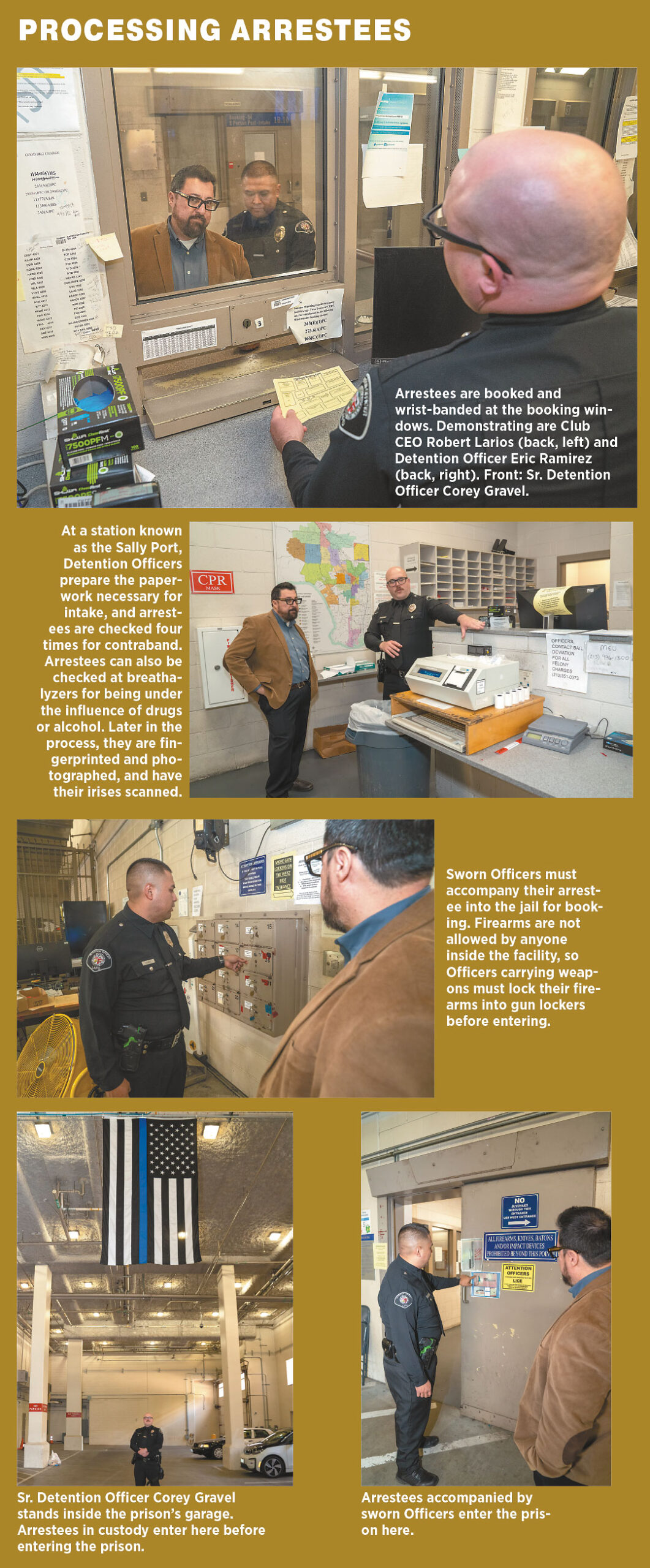
 History
History
What’s the history of the Custody Services Division? I would imagine that, as long as there’s been an LAPD, someone has had to perform your function. Was it part of the sworn side, or has it always been separate?
Officer Ramirez: From my understanding, in the early 1990s or even prior to that, our Detention Officer position was known as a Station Officer, who wore a khaki uniform. They did not wear a utility belt, or what we call our duty belt or Sam Browne. They handled mostly paperwork. But a lot of the custody aspect of it I believe might have been shared between patrol and the Station Officer. In the late ’90s, our uniform transitioned to a black uniform, and our title changed to Detention Officers. The change came with a lot more duties.
Now we’re fully in charge of caring for arrestees. Now we wear handcuffs and pepper spray. Now we are authorized to use tasers; we carry tasers on our belt. We have the same police radios that sworn police officers have and are trained in extensive Arrest and Control Tactics.
Officer Gravel: We have pneumatic rifles to utilize in riot situations or tactical situations.
Officer Ramirez: We’re trained on arrest and control. Similar to Police Officers, we train further in uses of force such as cell extractions, cell placements, use of restraint chairs, use of safety cells, and mental health identification for corrections. Our position has really grown since the ’90s, which is the earliest I have any knowledge of.
Originally we were known as Jail Division in the ’90s when our Detention Officer uniforms became black to be more consistent with LAPD standards. In 2015 we were renamed to what it is now Custody Services Division under one of our Captains because our duties changed again. Rather than staying primarily in the jail and handling jail functions, in 2015 we established the Custody Transportation Unit, which goes to different divisions and picks up the arrestees from the divisions themselves. Our duties grew outside of the jail. We play a crucial point in field operations, supervising area field jails during times of civil unrest. Since our duties grew outside of the jail, our name was changed from Jail Division to Custody Services Division.
Is it all centralized now? Do the local Police Stations use the small jails they have?
Officer Gravel: Yes. All of the divisions in LAPD have some kind of smaller jail or holding cell that they still use. The only Custody Services facility that doesn’t have a Police Station attached is us at MDC – but Central Division station is nearby.
Again, the grand scheme of opening up these regional jails is to make sure that the Sworn Officers get back to their patrols as efficiently and as quickly as possible. And we want them to not be tied up with paperwork or administrative matters like holding someone in custody for a long period of time. Making a centralized area and function for custody services frees Officers from having to do it.
Officer Ramirez: All LAPD divisions have some kind of holding cell, but the arrestees are not permitted to stay there more than a period of time. If an arrestee is going to stay in custody, they need to be in a facility that is held to the standard of the Department of Corrections here in California. And that’s where we come in.
Because of staffing and maybe other issues, those outer line facilities have been closed.
Right, makes sense. For what it’s worth, I’ve seen the holding cell at Pacific Division. From outside the bars, I should add.
Officer Gravel: Well, no judgment. Everyone has a good day and a bad day.
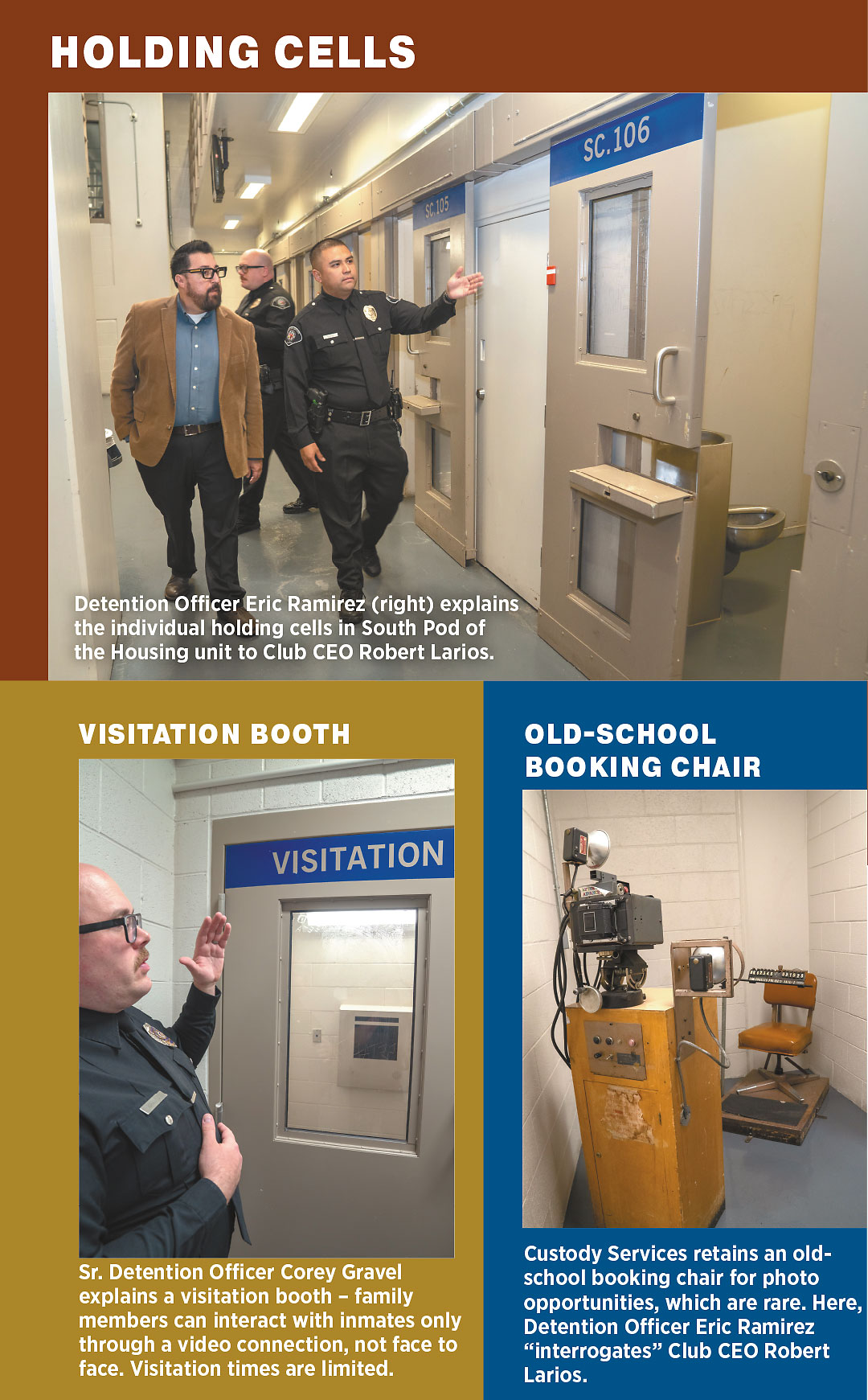
 Big Function, Small Awareness
Big Function, Small Awareness
We mentioned it earlier, that Custody Services Division is not well known. Do you think that your division should be better known?
Officer Ramirez: I think that’s an accurate perception. We’re not very well known, especially outside of this department. Every Police Officer knows of our existence because they arrest people, and they book arrestees into our facilities. However, to the general public, when you say Detention Officer, a lot of people relate us to juvenile halls or probation. When you say jails, a lot of people relate us to county jails, prisons or San Quentin. Outside of the people who have been arrested by the LAPD, some Angelenos may never know that LAPD has jails to begin with. It’s a good thing in the sense that a lot of people may not know about us because a lot of people stay out of custody. But on the other hand… That also affects us as far as recruitment goes. When trying to get our name out, trying to get an awareness spread out of the existence of this job. Because people don’t know that LAPD has jails and that they have correctional officers, it affects the number of applicants we receive for this position.
You’re a really important cog in the process of law enforcement. It seems like your status is growing because of that.
Officer Gravel: Yes. An arrest is a very visual thing. People on the streets can see it happening and they can videotape it, and they have it all recorded via the Police Officer or someone witnessing it. Once the arrestee comes into custody, that situation changes. We like to think that we treat them so well that nothing really happens. And they leave here, it’s been a blip on the radar considering what they have ahead of them. We do our due diligence to ensure that we meet the standards of the Los Angeles Police Dept., which are very difficult to meet. Yes, people don’t know that the LAPD has a jail, but it’s because the jail is nice, has few issues, and does its job. Or maybe because they’re not in that jail, I hope.
Officer Ramirez: It’s not as glamorized as the rest of the process. Or as glamorized as the bigger facilities that you see in movies in Hollywood.
Officer Gravel: Very few viral moments happen inside of a facility like this.
What do you wish people knew about the Custody Services Division?
Officer Gravel: It’s a great job. It’s a lot more rewarding than I anticipated. But there is a stigma that people have in their heads about what a jail looks like and how the people inside of it operate. A lot of it is more boring than you think. It’s not as dangerous as anyone considers because of the way we manage it. The one thing that we worry about first and foremost is the safety and security of everyone in the facility, myself included. It is a lot safer than people anticipate. We do a lot of liability and litigation to ensure that everyone who comes into our facility, including the visitors, volunteers, contract workers, whatever, leave as safely as possible.
Officer Ramirez: When someone applies to be a Detention Officer, and you tell your family they think, oh, it’s dangerous. They might try to change your mind. But the reality is, 90 percent of our arrestees are cooperative. They want to do their time, they want to get out. There are always going to be times where 10 percent of the population is combative and uncooperative. It’s a high-risk job in that aspect. But not as much as people or the media think.
And it’s a great job because, as I said, you can start your law enforcement career as early as 18 years old rather than 20 or 21. We’re very well compensated for what we do. Our schedule is good, too. We work three-12 schedules. We work 13 days a month, with 15 days off. Very few places offer that schedule, offer you that much time with your family.
It’s the greatest job I’ve ever had. I enjoy what I do. I love this job. It’s a great place to be.
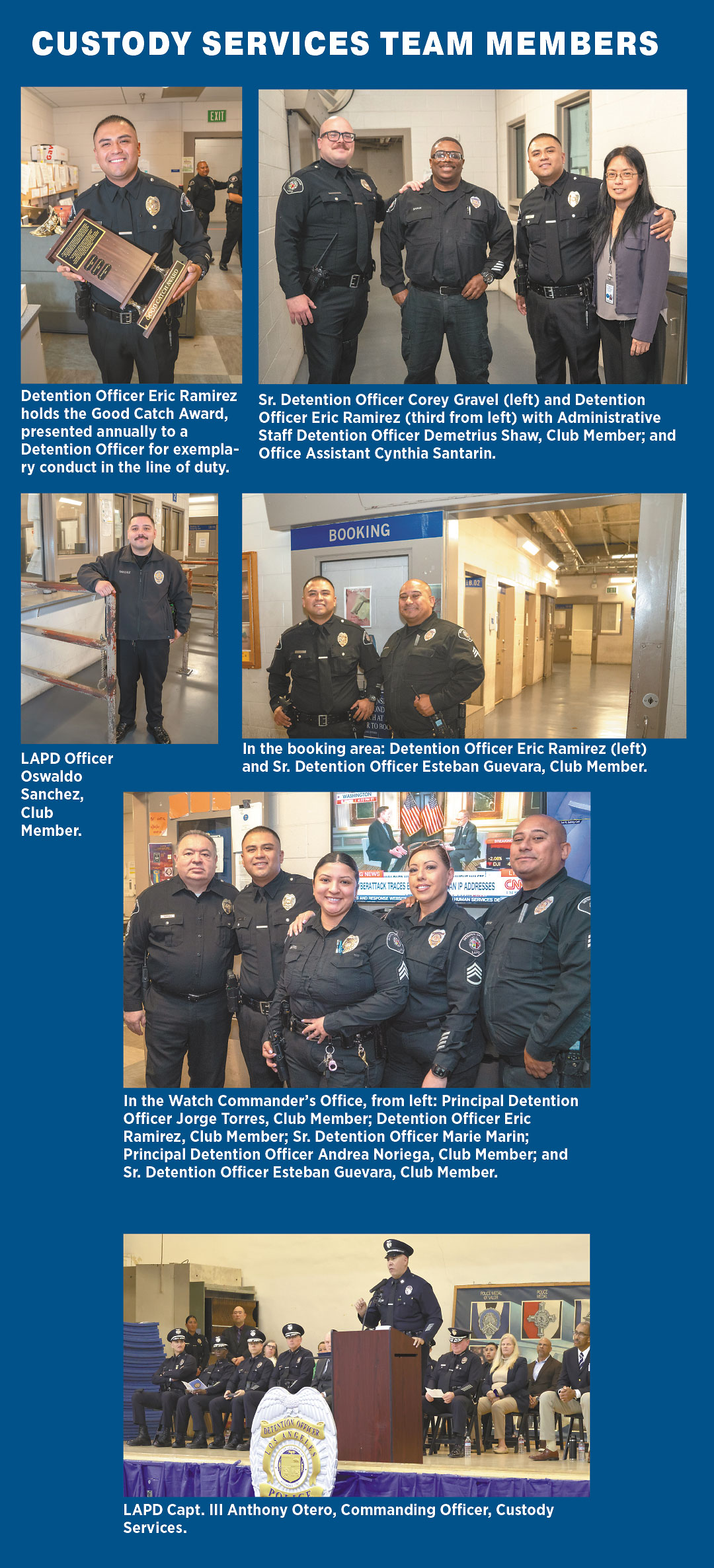
 Training
Training
How are Detention Officers trained?
Officer Ramirez: We get certified through the state as Correctional Officers. To be a Detention Officer, you must go through the adult core course of corrections. That is a state standard. It’s 264 hours, a four-month academy program. On top of that, we train extensively in arrest and control. We do various hours of mental health training for corrections. We will do more training specific to the jail, such as cell extractions, cell placements, use of restraints, and use of different restraints tools. In total, candidates need around 350 hours of different training just to be a Detention Officer on day one. And then continues their… On-the-job training.
Officer Gravel: It’s a four-month academy and a six-month probation. The academy is the pinnacle of a training facility for Detention Officers. We try to set the highest standard possible. That comes with being a part of the department. When you say you’ve been trained by the LAPD, that carries a lot of weight. Anywhere you go in the country and in the world, people know us globally of course. It’s not out of the realm of possibility that other agencies ask to attend our Detention Officer academy or our sworn academy. Long Beach, Santa Monica, sometimes Pasadena and sometimes Burbank have sent their Detention Officers to our academy because they like the standards that we set.
So the state program is in Sacramento? And the LAPD Detention Officer academy is taught at the LAPD Academy in Elysian Park?
Officer Ramirez: No. Our LAPD Academy is certified through the state to teach the course. We go through the LAPD Academy for that state course. We don’t have to go to Sacramento.
Officer Gravel: And the LAPD Detention Officer academy is led at the Ahmanson Recruit Training Center near LAX [on Manchester Avenue in Westchester], not in Elysian Park.
Only about two months of the LAPD training is required by the state. The additional two months are tactics, training and agency-specific training. The LAPD gets us more prepared than just the basic state standards.
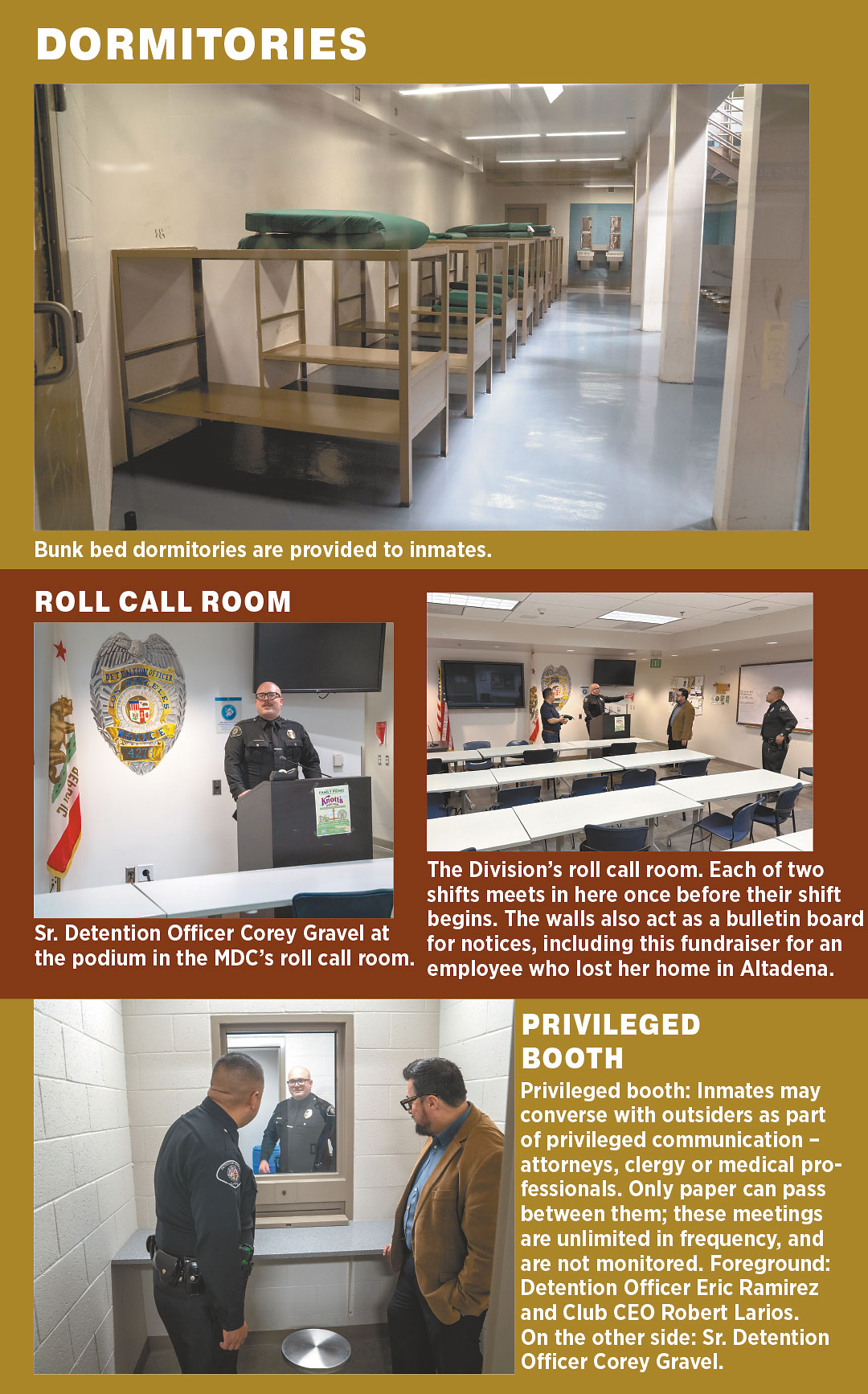
 Compassion vs. Duty
Compassion vs. Duty
What does success look like for you, and for the division?
Officer Gravel: Success in a jail is that there’s peace in the jail. Everything’s quiet, everyone’s taken care of. When everything’s going right, it’s very mundane. We like to have a peaceful work area, as everyone does. Unfortunately, I don’t work as a typist or a banker, where someone comes in and yells, and that would be very unusual. Most of the time when people come in, they’re usually upset. It’s the worst day of their life or near it. They may be withdrawing from drugs or suffering from some kind of mental illness. Having to deal with that on an individual basis for every single person brought in is a challenge.
When our jail is quiet and when our arrestees and our inmates are taken care of, and the morale and mental and physical wellbeing of our Detention Officers are taken care of, that’s a successful day. It doesn’t look like much from the outside when we’re doing well, but that is a good thing. I would say almost every day is a very successful day.
Officer Ramirez: Success is that arrestees are healthy, that they’re fed, that our Detention Officers go home safely, that nobody is injured on the job, and that we kept everyone alive. One of the struggles that we deal with here is losing somebody in custody from a withdrawal or suicide. A successful day or successful year – a successful calendar – means not losing anybody in custody.
We do a very great job in that. Last year, we booked more than 40,000 arrestees into our LAPD facilities. We had various suicide attempts and saved them all except one that we weren’t able to save.
Those are the struggles that we deal with. Those are the statistics that we have. When we put up our statistics compared to other facilities in the country, we do amazingly well. We outperform them. But at the end of the day, if you lose one out of 40,000, that’s still one person’s life. That’s someone’s family member, someone’s father, someone’s child, someone’s mother. For me, success is keeping all our arrestees alive, and keeping our officers safe.
It seems like one of the central conflicts that Detention Officers might have, is emotion versus duty, or compassion versus duty. How do you deal with that?
Officer Gravel: Yes, of course. When people first come in, we’ve booked some of them for allegedly having done the most heinous things you could think of beyond imagination. How terrible some of these crimes are. But the training that we put all of our Detention Officers through reminds us: I’m not a judge, a jury, or an executioner; this person is a human being, and I’m at work. We have to treat this person with diligent respect and ensure that they are given every possibility that you would give your own family member, regardless of what crime they’re in there for. They’re innocent until they’re proven guilty, even if with all the evidence in the world against them that they’ve done all these terrible things. I consider every single person in our facility innocent because they haven’t been proven guilty yet. We’re just holding them until they get to that day in front of a judge.
Officer Ramirez: The things that we see and the things that we have to encounter on a regular basis – those things desensitize us to a lot of things. We go through implicit bias training that helps us identify any implicit biases that we have and to act in correspondence with our core values here at the department. It is definitely a challenge, but it’s something that we’re well equipped to handle. It’s something that we do regularly. We have to forget our personal biases or how we feel about someone’s charges and remember that they’re only accused at that point. We have to treat everybody the same. We have to treat everybody fairly.
Officer Gravel: As far as the psychological toll it will take on someone who works in a facility like this, I’m not going to say that it is free from bad days. But the department has an enormous breadth of free services to our Detention Officers and to our family members that includes behavioral science. We advertise it every other day or every third day to ensure that the Detention Officers have psychological help when necessary. The department offers a lot of outside free services to help out in case something beyond the scope of your job happens.
Who’s allowed in your facilities? Attorneys? Families?
Officer Ramirez: Each facility has visiting hours. Typically they’re from 8 a.m. to noon and 1 to 3 p.m. We allow all arrestees to have one visit a day. It’s a 15-minute visit; it’s what we can allow because of the restraints that we have here. Typically a visitation is limited to one adult and if needed, one adult and one child. Families are allowed to see their loved ones regularly if they wish to.
Privileged visitation – attorneys, clergy, DCFS, doctors and bail bondsmen – can come at all hours of the day or night, and take as long as they need to. Privileged visitors can come and go without any time restraints within our meeting rooms or visiting rooms.
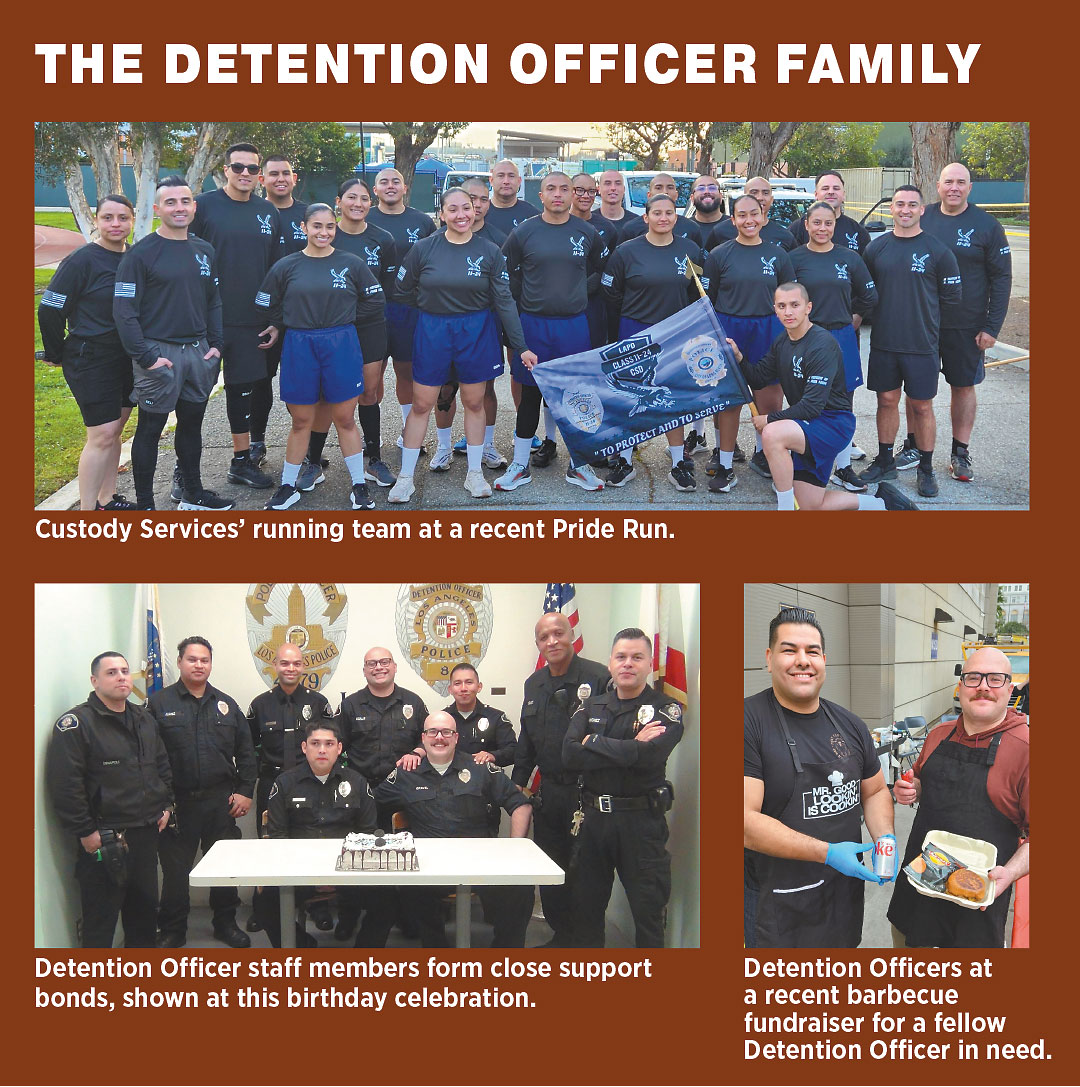
 Protecting and Serving
Protecting and Serving
What do you love about what you do?
Officer Ramirez: I grew up in South LA, South Central. I’ve seen some of the people I grew up with, my neighbors or distant family members, come through here. It’s rewarding to help them through the situation they’re in. When people come here, it is likely the worst day of their life. It is a difficult time for them. And the quality of service and understanding that we provide helps them get through it. It can help shape their perception of law enforcement.
What’s become very clear is that we do serve our community. LAPD’s motto is “To Protect and Serve.” We’re also serving here. I’m serving the community, the families of our arrestees, and the arrestees themselves. We get them through a difficult time during their stay – although they may still have a lot ahead of them.
Officer Gravel: I know it’s kind of a cheesy thing to say, but you spend a lot of time with your coworkers, and you get to know them very well; it’s almost like a deployment. I might see my coworkers more than I see my family, even with our 15 days off a month. I have plenty of days off to enjoy with my family. But the people I spend my time with while I’m at work make it worthwhile. When you spend 12 hours in a place per shift, you essentially live there; you’re going to eat several meals with the people you’re around. You’re going to share a lot of stories with them and develop camaraderie.
They back you up, too. How can I help you? What do you need help with? How can we make sure the ship is running correctly? They’re good people. The department does a very good job hiring outstanding individuals.
Officer Ramirez: We like the individuals that we work with. When you have a good work group, it just makes the job a lot easier. I love all my partners.
Officer Gravel: I say it a lot. I say I love you to my family, but I say, “I love you” to my partners a lot because I care about their wellbeing. I’m constantly calling them on my days off to ensure they’re doing okay.
Officer Ramirez: It becomes a second family.
Officer Gravel: Here’s a story. One of our partners recently lost her home in the fires that took place in Los Angeles. Devastating. It is not something you want to have happen to anyone you care about. This division – being tight, family oriented and really caring for one another – donated as much money as we had; everyone donated as much cash as we had in our pockets and tried to give her enough to pay for rent or a hotel or whatever she needed to get her through the next couple days. She had nothing.
It didn’t stop there. We are still running fundraisers to try and get her more in her pocket, bringing her things for her kids to play with and read, and doing everything we can in our power to help her. She would do the same for me.
It’s not just the people who work in this building, it’s the entire division of 400 individuals who put forth to try and prop up our family, The LAPD has also reached out. Everyone is rallying to support someone who has fallen on hard times.
We get together for barbecues all the time. We might as well dedicate them to a good cause and invite other divisions to buy a couple burgers and chips and support a good cause,
Officer Ramirez: Our supervision is very compassionate. When our Detention Officers have been diagnosed with cancer, when our Officers are going through a difficult time in their lives, when our Officers lost their house in the fire, we band together.
I mentioned arrestee suicides before. Well, I’ve resuscitated people back to life. Holiday weekends are the most difficult times – that’s when we get the most suicide attempts. It’s when people are the most depressed, when they are the most saddened that they’re in custody and missing time with their family. We mention that in roll call during the holidays, to be aware of it, to notice people who are more withdrawn, maybe crying more than usual. We have been able to successfully prevent suicide attempts because we’re aware of it.
Sometimes situations can be tough, but saving that life sticks in my mind. We’re fortunate enough to have been able to save a life.
Right. Of course it would, and should. Detention Officers, thank you so much for your time today. I have learned a lot. And thank you for all you do for the City of Los Angeles. We honor you.
Officer Gravel: Thank you.
Officer Ramirez: Thanks!
| BEHIND THE SCENES
Club COO Summy Lam photographs LAPD Custody Services’ Sr. Detention Officer Corey Gravel and Detention Officers Eric Ramirez and Francis Navarro at the LAPD Metropolitan Detention Center downtown.
|



